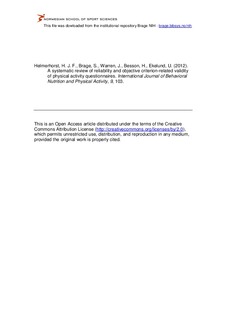| dc.contributor.author | Helmerhorst, Henrik J. F. | |
| dc.contributor.author | Brage, Søren | |
| dc.contributor.author | Warren, Janet | |
| dc.contributor.author | Besson, Herve | |
| dc.contributor.author | Ekelund, Ulf | |
| dc.date.accessioned | 2012-11-14T12:58:31Z | |
| dc.date.available | 2012-11-14T12:58:31Z | |
| dc.date.issued | 2012-08-31 | |
| dc.identifier | Seksjon for idrettsmedisinske fag / Department of Sports Medicine | |
| dc.identifier.citation | International Journal of Behavioral Nutrition and Physical Activity. 2012, 9, 103 | no_NO |
| dc.identifier.issn | 1479-5868 | |
| dc.identifier.uri | http://hdl.handle.net/11250/170980 | |
| dc.description | © 2012 Helmerhorst et al.; licensee BioMed Central Ltd. | no_NO |
| dc.description.abstract | Physical inactivity is one of the four leading risk factors for global mortality. Accurate measurement of physical activity (PA) and in particular by physical activity questionnaires (PAQs) remains a challenge. The aim of this paper is to provide an updated systematic review of the reliability and validity characteristics of existing and more recently developed PAQs and to quantitatively compare the performance between existing and newly developed PAQs.
A literature search of electronic databases was performed for studies assessing reliability and validity data of PAQs using an objective criterion measurement of PA between January 1997 and December 2011. Articles meeting the inclusion criteria were screened and data were extracted to provide a systematic overview of measurement properties. Due to differences in reported outcomes and criterion methods a quantitative meta-analysis was not possible.
In total, 31 studies testing 34 newly developed PAQs, and 65 studies examining 96 existing PAQs were included. Very few PAQs showed good results on both reliability and validity. Median reliability correlation coefficients were 0.62–0.71 for existing, and 0.74–0.76 for new PAQs. Median validity coefficients ranged from 0.30–0.39 for existing, and from 0.25–0.41 for new PAQs.
Although the majority of PAQs appear to have acceptable reliability, the validity is moderate at best. Newly developed PAQs do not appear to perform substantially better than existing PAQs in terms of reliability and validity. Future PAQ studies should include measures of absolute validity and the error structure of the instrument. | no_NO |
| dc.language.iso | eng | no_NO |
| dc.publisher | BioMed Central | no_NO |
| dc.subject | systematic review | no_NO |
| dc.subject | physical activity | no_NO |
| dc.subject | self-report | no_NO |
| dc.subject | accelerometry | no_NO |
| dc.subject | validity | no_NO |
| dc.subject | reliability | no_NO |
| dc.title | A systematic review of reliability and objective criterion-related validity of physical activity questionnaires | no_NO |
| dc.type | Journal article | no_NO |
| dc.type | Peer reviewed | no_NO |
| dc.subject.nsi | VDP::Social science: 200::Social science in sports: 330 | no_NO |
| dc.subject.nsi | VDP::Medical disciplines: 700::Sports medicine: 850 | no_NO |
| dc.source.pagenumber | 103 | no_NO |
| dc.source.volume | 9 | no_NO |
| dc.source.journal | International Journal of Behavioral Nutrition and Physical Activity | no_NO |
